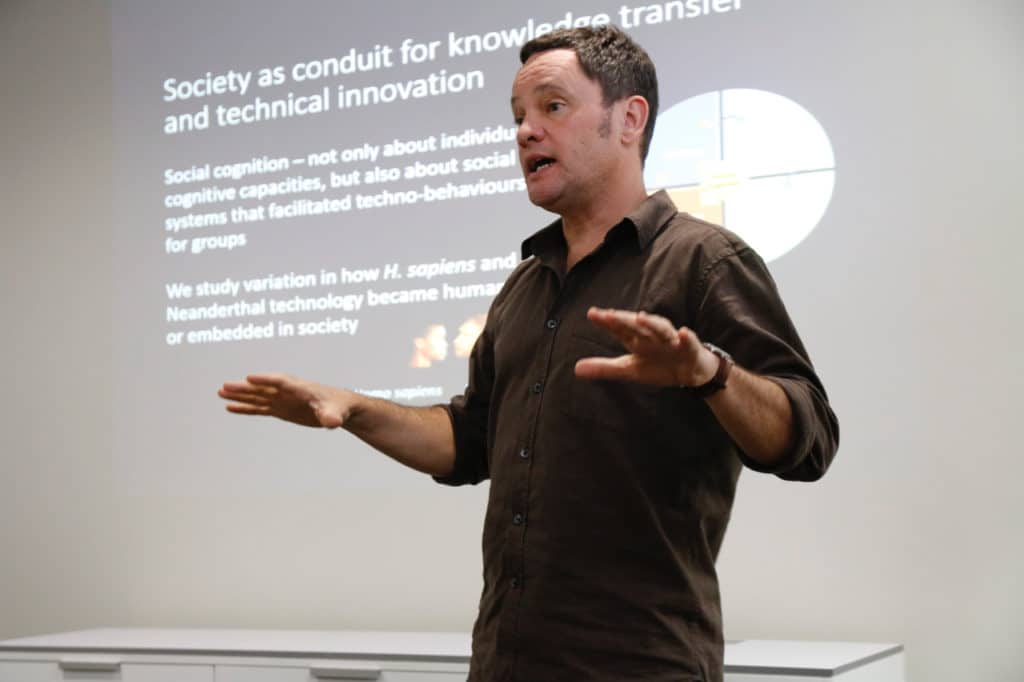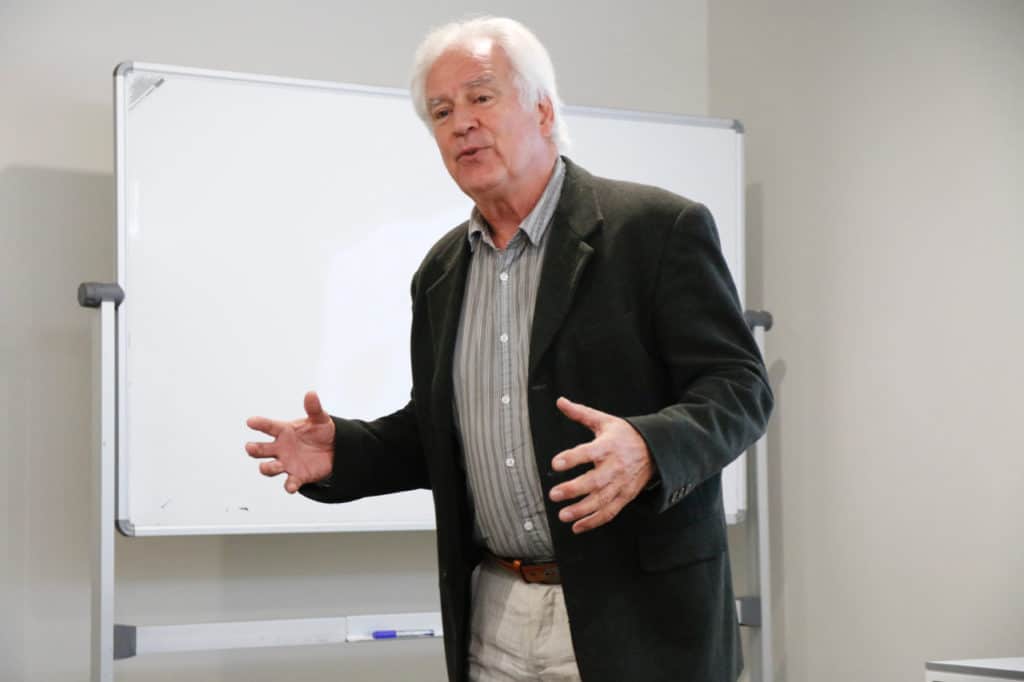“We suggest that a useful way to explore the evolution of human cognition between about 300 000 and 50 000 years ago is to think of it in terms of a co-evolutionary feedback loop between aspects of biology, technology, society and ecology.”
STIAS Fellows Marlize Lombard, Anders Högberg and Peter Gärdenfors during their seminar on 19 November 2019
STIAS fellows Marlize Lombard, of the Palaeo-Research Institute, at the University of Johannesburg, Anders Högberg, of the Department of Cultural Sciences at Linnaeus University, and Peter Gärdenfors of the Cognitive Science Group at Lund University (both also affiliated to the Palaeo-Research Institute, at the University of Johannesburg) presented an update on their long-term STIAS project ‘Archaeology of the Hungry Mind’ in which they are studying how we humans have been nourishing our minds over several million years to become the only mammal to successfully inhabit and control most of the global landmass and explore the universe beyond. The seminar focused on the last 300 000 years of human cognitive evolution, because it represents the coming of age of Homo sapiens. During this time, our ancestors shared the Old World with other human groups such as the Neanderthals and Denisovans amongst others, and perhaps also Homo naledi – all of whom became absorbed into the single surviving human species Homo sapiens, or ultimately disappeared from the landscape as distinct populations.
“Our long-term project is essentially about the evolution of human curiosity,” said Lombard. “We are the only creatures on the planet who function out of curiosity. To be sapient is to have the ability to act with judgement and wisdom based on remembering and thinking about what we experience. We can think about and find solutions to old and new problems – real and imagined. We also experience and process the world through uniquely evolved senses and perspectives.”
“We have a long, complex history since we split from the other apes,” she continued. “Our origins as Homo sapiens are in sub-Saharan Africa at about 300 000 years ago – during the period known as the Middle Stone Age – from where we later spread across the globe.”
The project is interested in unravelling the complex interaction between several aspects of human cognition.
“How we understand and think about the world is continuously shaped and reshaped by technology, biology, social interaction and the ecological niches we inhabit,” said Lombard “We believe there is a continuous co-evolutionary feedback loop between these aspects.”
“We are the only species who cannot survive without technology,” she added. “Our technologies became our culture as a result of social learning, teaching and negotiation. Aided by technologies we are the only species that dominate almost all ecological niches.”
Gärdenfors focused on the differences between humans and animals in terms of cognitive reasoning and technological developments, and the way in which technology has extended our thinking about causality.
“We find surprising gaps in other animals,” he said. “Humans are the only species who can reason about forces – mental social, physical – that are detached. For example, humans have learnt to reason about forces like gravity while other animals haven’t. Humans can throw things which very few animals can do. This means you can affect something (an enemy perhaps) at a distance by transferring your body force to something out of reach of your body space.”
“Animals understand the consequences of their actions,” he continued, “but humans can reason more abstractly in terms of the forces that determine effects. We believe that abstract causal thinking co-evolved with tool use and manufacturing. In particular, new tools made the hominins reason about effects detached in space and time from their causes.”
“Using tools changes how our brains work – they are assimilated – become an extended part of our body space.”
He pointed out that the archaeological record clearly shows, for example, that throwing spears developed later that thrusting spears – “development of these technologies in this order reflects a more and more extended reasoning about causes”.
“We expanded our thinking of causality over space and time. We don’t find this kind of reasoning in any other species. There is also more reasoning about external forces leading to effects as well as about what might happen due to someone else’s state of mind.”
In our genes
What was happening on the outside was reflected on the inside. Lombard presented research showing that aspects of DNA and brain development evolved differently between Homo sapiens and Neanderthals.
“This year a revised catalogue of 571 genes was published which seem to have been selected positively in Homo sapiens,” she said. “This includes gene regions associated with brain development, skull shape and plasticity, memory and cognition as well as language, and, in particular, brain regions such as the precuneus and cerebellum.”
“The development of the precuneus represents a substantial difference between the Neanderthals and us. It’s only at its current shape and size in Homo sapiens. We start picking it up in the fossil record from 150 000 years ago. The precuneus is associated with what is called the default network which facilitates task performance, mind wandering, time travel as well as imagination. It’s also active when we think about ourselves and other people in the past and future. It’s been connected with higher-grade causal reasoning.”
“Another region of the brain that is distinct between Neanderthals and us is the cerebellum which is mostly known for its association with co-ordination and balance, but also aspects of spatial processing, memory, language and social cognition.”
“Our DNA, our brains and also our biochemistry are what makes us biologically sapient,” said Lombard.
“However,” she was quick to add, “none of this implies superiority. It simply reflects variation over a very long time in our shared evolutionary history.”
Knowledge transfer
Högberg focused on knowledge transfer and society as a conduit for technical innovations which he described as “the system that emerges when knowledge becomes part of culture and is transmitted between generations and between groups”.
“We are not talking about individual capacities but group dynamics. How different skills and abilities play out within and between groups over time and within the landscape.”
“Technology needs to be introduced into society. Not just developed but also negotiated and accepted. Over time some stabilise and become institutionalised and social norms keep the technology in a stable phase. For change to happen you need destabilisation,” he continued.
“Technical inventions are about gradual modifications and variations over time. They become embedded in society through highly socialised systems such as intentional teaching.”
“The archaeological evidence shows a lot of different technologies in use during this period.”
He traced the development of bow hunting which was more clearly linked to Homo sapiens. These changes require the ability to conceptualise and visualise a result which implies changes in cognition.
“There is clear evidence in southern Africa of technological change as well as stabilisation and destabilisation in this period,” said Högberg. “The Neanderthals, by contrast showed some regional variation but stayed within the same technological concept.”
“It’s also clear that Homo sapiens maintained greater social ties and interactions which probably implies that hunter-gatherer groups communicated with other groups building a mental landscape of many individuals. This again implies cognitive differences – so differences in the brain affected their relationships and interaction with the landscape.”
When faced with environmental changes the Neanderthals kept hunting the same animals in the same way just over a wider area. Homo sapiens came up with the solution of a bow and arrow. So instead of doing the same thing they invented a new way of doing things.
“This meant that Neanderthals couldn’t break out of the environment while Homo sapiens could include environment into their cultural and social setting. They occupied a cognitive niche that interacted with the ecological setting and the social and technological domains.”
“Not being victims of environment but able to adapt and modify it means you can create a living space in any environment. Aided by technology, we became the only surviving hominin inhabiting, changing and dominating almost all ecological niches on earth. Consequently, human environments were not simply set by nature, but created, enriched, maintained and modified by human activities.”
“It’s about different push and pull factors,” added Lombard. “Different populations experience different push and pull factors but this becomes collective over time. For example, the development of bow hunting pushes certain areas of the brain – causing them to evolve which equips you to do something else again – in a constant feedback loop. Our current interactions with technology, for example, are changing our children’s brains. They are losing skills – like memory – but they are also interacting differently which will inspire other behaviours and technologies. Every incremental change stimulates more change.”
“Of course, the co-evolution of machines and man is interesting for the future,” said Högberg. “Technology is speeding up. There are new ways of thinking and interacting with each other. Humans could evolve in different directions.”
“Evolution never stops,” added Lombard. “We don’t know who we will evolve into or if we will become extinct in the future.”
Michelle Galloway: Part-time media officer at STIAS
Photograph: Christoff Pauw



